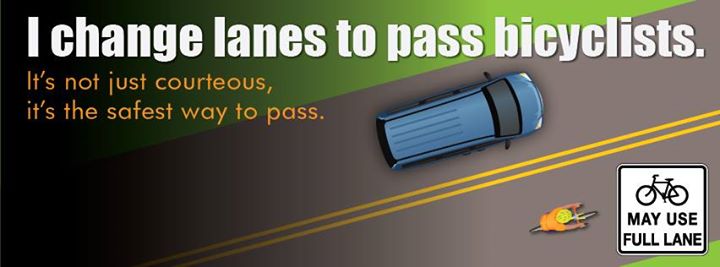Motoring: Speed Positioning Between Intersections; Passing
Slower Traffic Use Right Thru Lane
Slower drivers operate closer to the curb; faster drivers operate closer to the center of the road and pass slower traffic on the left. Where lanes are marked, slower drivers use the rightmost lane that serves their destination. Where lanes are not marked, slower drivers operate as far right as is safe and practical. (See § 20-146(b).)
20-146. Drive on right side of highway; exceptions. (b) Upon all highways any vehicle proceeding at less than the legal maximum speed limit shall be driven in the right-hand lane then available for thru traffic, or as close as practicable to the right-hand curb or edge of the highway, except when overtaking and passing another vehicle proceeding in the same direction or when preparing for a left turn.
A bicyclist requires an operating envelope at least four feet wide to maintain balance, and at least three feet of separation from motor traffic is recommended for safety. Most most marked travel lanes are only 10-12 feet wide, making them too narrow for a typical width motor vehicle and a bicycle to operate side by side within the same lane.
Operating beside a bicycle in the same lane safely requires at least 14 feet of usable pavement for an SUV, and at least 16 feet for a truck or bus. Few travel lanes are this wide.
[Graphics: i am traffic]
Most bicyclists find that if they ride at the right edge of typical, narrow travel lanes, many drivers attempt to squeeze past them at unsafe distance within the same lane. Drivers may misjudge conditions and not realize how narrow the available space is until it’s too late, especially when they are approaching at high speed. The most common type of car-overtaking-bicyclist crash involves a driver who sees the bicyclist riding at the right edge of a narrow lane with plenty of advance notice, but attempts to squeeze by within the same lane. Knowledgeable bicyclists have discovered that in a narrow travel lane, it’s usually safer for the bicyclist to ride far enough into the lane to make it clear to motorists that they must move into the adjacent lane to pass. Bicyclists will sometimes ride two abreast in order to deter unsafe same-lane operation by a motorist.
[Graphic: Keri Caffrey, i am traffic]
Passing
Motor vehicle drivers pass bicyclists safely countless times every day. When done improperly, however, the results can be tragic. Some drivers say that they are unsure of what to do when they encounter bicyclists on the road ahead. It’s therefore important to increase public awareness of how to pass a bicyclist safely. In most cases, all that is needed is a little patience.
Safe passing requires following three simple steps:
- Slow Down.
- Look and Wait until Safe.
- Change Lanes to Pass.
Passing a bicyclist is legal only when it can be done safely, with adequate room, adequate sight distance, and no oncoming traffic. Always slow down and wait until it is safe to pass.
§ 20-150. Limitations on privilege of overtaking and passing.
Because bicyclists usually travel much slower than the maximum posted speed limit, it requires less distance to pass a bicyclist than to pass a typical motor vehicle, and therefore requires less sight distance. For this reason, passing a bicyclist in a no-passing zone is legal in North Carolina when done safely with no oncoming traffic and adequate sight distance, passing at a distance of at least four feet or moving completely into the next lane. See § 20-150. Limitations on privilege of overtaking and passing.
Don’t attempt to pass a bicyclist immediately before turning right. You may underestimate the bicyclist’s speed and cut the bicyclist off or hit them during your turn. Instead, slow down and merge to the right behind the bicyclist as you approach the turn. It’s better to follow for a few extra seconds than to risk a collision.



